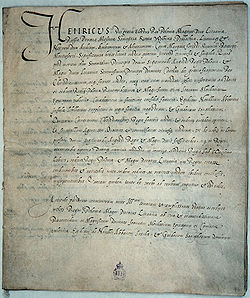
Pacta conventa (Poland)
Encyclopedia

Szlachta
The szlachta was a legally privileged noble class with origins in the Kingdom of Poland. It gained considerable institutional privileges during the 1333-1370 reign of Casimir the Great. In 1413, following a series of tentative personal unions between the Grand Duchy of Lithuania and the Kingdom of...
of the Polish-Lithuanian Commonwealth
Polish-Lithuanian Commonwealth
The Polish–Lithuanian Commonwealth was a dualistic state of Poland and Lithuania ruled by a common monarch. It was the largest and one of the most populous countries of 16th- and 17th‑century Europe with some and a multi-ethnic population of 11 million at its peak in the early 17th century...
) and a newly-elected king
Monarch
A monarch is the person who heads a monarchy. This is a form of government in which a state or polity is ruled or controlled by an individual who typically inherits the throne by birth and occasionally rules for life or until abdication...
upon his "free election" (wolna elekcja) to the throne.
The pacta conventa affirmed the king-elect's pledge to respect the laws of the Commonwealth and specified his undertakings and promises in such realms as foreign affairs
Foreign Affairs
Foreign Affairs is an American magazine and website on international relations and U.S. foreign policy published since 1922 by the Council on Foreign Relations six times annually...
, tax
Tax
To tax is to impose a financial charge or other levy upon a taxpayer by a state or the functional equivalent of a state such that failure to pay is punishable by law. Taxes are also imposed by many subnational entities...
es, public debt, the military
Military
A military is an organization authorized by its greater society to use lethal force, usually including use of weapons, in defending its country by combating actual or perceived threats. The military may have additional functions of use to its greater society, such as advancing a political agenda e.g...
, etc. The document was drawn up by the election sejm (sejm elekcyjny), and its acceptance by the king-elect was a condition of his elevation to the throne.
An example of the various concrete undertakings found in a king-elect's pacta conventa is King Władysław IV Vasa
Wladyslaw IV Vasa
Władysław IV Vasa was a Polish and Swedish prince from the House of Vasa. He reigned as King of the Polish–Lithuanian Commonwealth from 8 November 1632 to his death in 1648....
's pledge to create a Polish-Lithuanian Commonwealth Navy
Polish-Lithuanian Commonwealth Navy
Polish–Lithuanian Commonwealth Navy was the navy of the Polish–Lithuanian Commonwealth.- Battle of Oliva :During the time of Polish–Swedish War in 1627, the Commonwealth fleet under command of Admiral Arend Dickmann achieved it most famous victory, breaking the Swedish blockade at the Battle of...
for the Baltic Sea
Baltic Sea
The Baltic Sea is a brackish mediterranean sea located in Northern Europe, from 53°N to 66°N latitude and from 20°E to 26°E longitude. It is bounded by the Scandinavian Peninsula, the mainland of Europe, and the Danish islands. It drains into the Kattegat by way of the Øresund, the Great Belt and...
.
In addition to his own unique pacta conventa, each king-elect was required to sign the Henrician Articles
Henrician Articles
The Henrician Articles or King Henry's Articles were a permanent contract that stated the fundamental principles of governance and constitutional law in the Polish-Lithuanian Commonwealth in the form of 21 Articles written and adopted by the nobility in 1573 at the town of Kamień, near Warsaw,...
.
The distinction between the two documents gradually faded away over successive elections.

